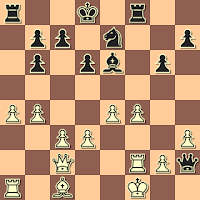Wall, Bill - Borut, O
PlayChess.com, 2015
1.e4 e5 2.Nf3 Nc6 3.Bc4 Bc5 4.Bxf7+
4...Kxf7 5.Nxe5+ Nxe5 6.d4 Bxd4 7.Qxd4 Ng6
A normal move, but one that is rare in The Database, with fewer than 10 examples.
8.O-O
Bill played 8.Nc3 successfully in couple of games: 8...Nf6 9.Bg5 b6 (9...Ng4 10.Bxd8 Rxd8 11.Nb5 c6 12.Nc7 Rb8 13.Qxa7 White forfeited by disconnection in a won position, Wall,B - Socolata, FICS, 2013) 10.Bxf6 Qxf6 11.Qd5+ Qe6 12.Qxa8 Black resigned, Wall,B - Socolate, FICS, 2013.
8...d6 9.Nc3 Nf6 10.Bg5
Putting pressure on the Knight at f6, a typical Jerome Gambit theme.
10...Rf8 11.f4 Kg8
Black castles-by-hand.
12.Nd5 Bd7 13.Rad1 Bc6 14.Qc4 Kh8
Black has safeguarded his King, and developed his often problematic light-squared Bishop.
15.e5 Bxd5 16.Rxd5
16...Qd7
Unpinning the Knight, but missing the best, if tricky line: 16...Nxd5 17.Bxd8 Ne3 18.Qb3 Nxf1 19.Bxc7 Nxf4 20.Kxf1 Nd5+ 21.Kg1 Nxc7 22.Qxb7 Ne6 23.exd6 when Black's advantage in material - two Rooks and a Knight for a Queen - likely outweighs White's "Jerome pawns".
17.exf6 gxf6 18.Bh6 Rfe8
White has recovered his sacrificed piece, but will continue to put pressure on f6.
19.Qc3 Qf7 20.Rf5 Re6 21.Rb5
21...b6
Black doesn't quite have the answer to White's next move, so this move is insufficient, compared to 21...Rg8.
22.f5 Re5 23.fxg6 Qxg6 24.Rxe5
With a Black Rook on g8 (see above note), this move would not have been possible because of the threat to g2 (and further back rank threats).
24...fxe5 25.Bf8 Black resigned
White's Bishop is not as vulnerable as it appears at first look, and it makes threats to Black's pawns while possibly working with White's Queen for checkmate. The more you look, the more ordinary the position seems.












































